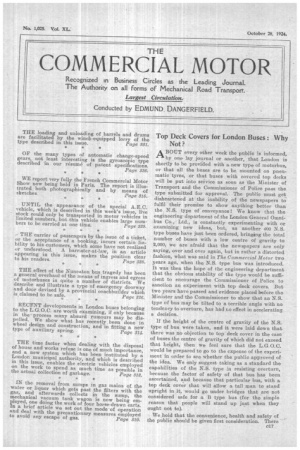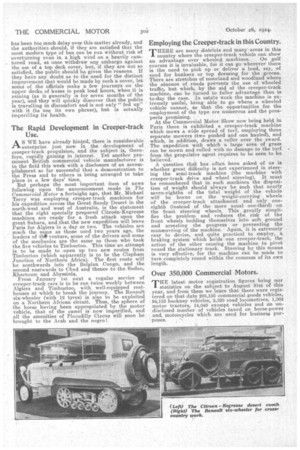Top Deck Covers for London Buses : Why Not ?
Page 1

Page 2

If you've noticed an error in this article please click here to report it so we can fix it.
A BOUT every other week the public is informed, by one lay journal or another, that London is shortly to be provided with a new type of motorbus, or that all the buses are to be mounted on pneumatic tyres, or that buses with covered top decks will be put into service as soon as the Minister of Transport and the Commissioner of Police pass the type submitted for approval. The public must get disheartened at the inability of the newspapers to fulfil their promise to show anything better than the N.S. type of ' conveyance! We know that the engineering department of the London General Omnibus Co., Ltd., is constantly experimenting with or examining new ideas, but, as another 400 N.B. type buses have just been ordered, bringing the total number of buses with a low centre of gravity to 2,000, we are afraid that the newspapers are only saying, over and over again, but in rather a distorted fashion, what was said in The Commercial Motor two years ago, when the N.S. type bus was introduced. It was then the hope of the engineering department that the obvious stability of the type would be sufficient to encourage the Commissioner of Police to sanction an experiment with top deck covers. But two years have passed and evidence placed before the Minister and the Commissioner to show that an N.S. type of bus may be tilted to a terrible angle with no tendency to overturn, has had no effect in accelerating a decision.
If the height of the centre of gravity of the N.S. type of bus were taken, and it were laid down that there was no objection to top deck cover in the case of buses the centre of gravity of which did not exceed that height, then we feel sure that the L.G.0,C. would be prepared to go to the expense of the experiment in order to see whether the public approved of the idea. We only suggest taking as a standard the capabilities of the N.S. type in resisting overturn, because the factor of safety of that bus has been ascertained, and because that particular bus, with a top deck cover that will allow a tall man to stand upright in it, would go under bridges that are not considered safe for a B type bus (for the simple reason that people will stand up just when they ought not to).
We hold that the convenience, health and safety of the public should be given first consideration. There has been too much delay over this matter already, and the authorities should, if they are satisfied that the most modern type of bus can be run without risk of overturning even in a high wind on a heavily cambered road, at once withdraw any embargo against the use of a top deck cover, but, if they are not so satisfied, the public should be given the reasons. lf they have any doubt as to the need for the distinct improvement that would be made by such a cover, let some of the officials make a few journeys on the upper decks of buses in peak load hours, when it is raining (as it generally is for seven months of the year), and they will quickly discover that the public is travelling in discomfort and is not only " fed up" with it (to use its own phrase), but is actually imperilling its health.
The Rapid Development in Creeper-track Use.
AS WE have already hinted, there is considerable enterprise just now in the development of creeper-track propulsion, and the subject is, therefore, rapidly gaining in interest. Yet another prominent British commercial vehicle manufacturer is in the field this week with a disclosure of an accomplishment so far successful that a demonstration to the Press and to others is being arranged to take place in a few days' time. But perhaps the most important item of news following upon the announcement made in The Commercial Motor a fortnight ago, that Mr. Michael Terry was employing creeper-track machines for his expedition across the Great Sandy Desert in the north-west and west of Australia, is the statement that the eight specially prepared Citroen-Kegresse machines are ready for a fresh attack upon the great Sahara, and that the new expedition will leave Paris for Algiers in a day or two. The vehicles are much the same as those used two years ago, the leaders of tb venture, some of the drivers and some of the mechanics are the same as those who took the five vehicles to Timbuctoo. This time an attempt is to be made to ,open up two new routes from Timbuctoo (which apparently is to be the Clapham Junction of Northern Africa). The first route will be southwards into the Belgian Congo, and the second eastwards to Chad and thence to the Sudan, Khartoum and Abyssinia.
From January 1st next a regular service of creeper-track cars is to be run twice weekly between Algiers and Timbuctoo, with well-equipped resthouses at -which to break the journey. The Renault six-wheeler (with 12 tyres) is also to be exploited on a Northern African circuit. Thus, the sphere of the horse having been appropriated by the motor vehicle, that of the camel is now imperilled, and all the amenities of Piccadilly Circus will soon be brought to the Arab and the negro I
Employing the Creeper-track in this Country.
rr HERE are many districts and many areas in this country where the creeper-track vehicle can show an advantage over wheeled machines. On golf courses it is invaluable, for it can go wherever there is the need to pick up or deliver a; load, say, of sand for bunkers or top dressing for the greens. There are stretches of moorland and woodland where the absence of roads prevents the use of wheeled traffic, but which, by the aid of the creeper-track machine, can be turned to fuller advantage than is to-day the case. In estate work the machine is extremely useful, being able to go where a wheeled vehicle cannot, so that the opportunities for the employment of the type are numerous and the prospects promising. At the Commercial Motor. Show now being held in Paris there is exhibited a creeper-track machine which mows a wide spread of turf, employing three separate mowers (two pushed and one hauled), and which, •in addition, draws a roller over the sward. The expedition with which a large area of grass can be mown and rolled with no damage to the turf from the propulsive agent requires to be seen to be believed..
A question that has often been asked of us is whether great difficulty is not experienced in steering the semi-track machine (the machine with creeper-track drive and wheel steering). It must be remembered that in such machines the disposition of weight should always be such that nearly seven-eighths of the total weight of the vehicle will be borne on the weight-carrying wheels of the creeper-track attachment and only oneeighth (instead of the more usual one-third) on the front steering wheels. This greatly simplifies the problem and reduces the risk of the front wheels bedding themselves into soft ground and arresting the progress or preventing the manceuvring of the machine. Again, it is extremely easy to devise, and quite practical to employ, a braking system which holds one creeper-track, the action of the other causing the machine to pivot round the stationary track. Steering by this means is very effective, for the machine can be made to turn completely round within the comnass of its own length.
Over 350,000 Commercial Motors.
THE latest motor registration figures bring our statistics on the subject to August 31st of this year, and from them we learn that there were registered on that date 203,156 commercial goods vehicles, 94,153 hackney vehicles, 2,320 road locomotives, 1,362 motor tractors, 14,040 exempt vehicles and an undisclosed ntunber of vehicles taxed on horse-power and, motorcycles which are used or business purposes.




































